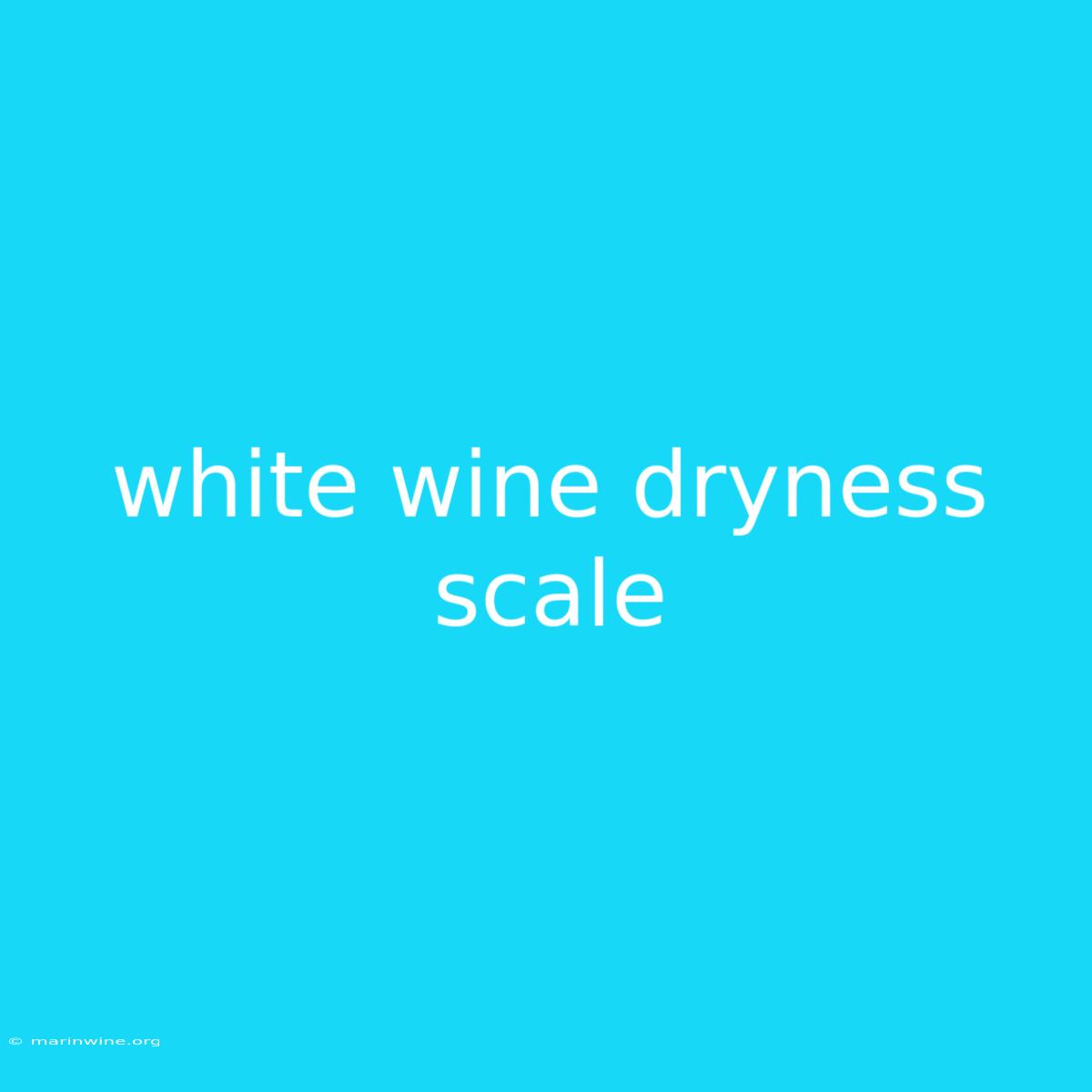Uncorking the Mystery: A Guide to the White Wine Dryness Scale
Have you ever wondered what makes a white wine "dry" or "sweet" and how to choose the right one for your taste? The world of white wines is vast and varied, with dryness being a key factor in determining your enjoyment.
Why This Matters: Understanding the dryness scale can help you navigate the world of white wines with confidence, selecting wines that best match your palate. It's about discovering new flavors, pairing wines with food, and expanding your wine knowledge.
Key Takeaways of White Wine Dryness Scale
| Dryness Level | Description | Example |
|---|---|---|
| Bone Dry | Virtually no sweetness, crisp and refreshing | Sauvignon Blanc, Pinot Grigio |
| Dry | Minimal sweetness, balanced acidity | Chardonnay, Riesling (dry style) |
| Off-Dry | Perceptible sweetness, fruit-forward | Riesling (semi-dry style) |
| Sweet | Distinctly sweet, often dessert-like | Moscato, Ice Wine |
White Wine Dryness Scale
Introduction: The dryness scale is a measure of residual sugar, the amount of sugar remaining in the wine after fermentation.
Key Aspects:
- Fermentation: During fermentation, yeast consumes sugar and produces alcohol and carbon dioxide. The longer the fermentation process, the less residual sugar remains.
- Winemaking Techniques: Winemakers can influence dryness by controlling fermentation or adding sweetness after fermentation.
- Grape Varieties: Certain grape varieties naturally produce wines with more or less residual sugar.
Bone Dry White Wines
Introduction: Bone dry wines have essentially no perceptible sweetness, offering a crisp, refreshing experience.
Facets:
- Taste: Typically characterized by high acidity, mineral notes, and a clean, dry finish.
- Pairing: Excellent with seafood, salads, and light appetizers.
- Examples: Sauvignon Blanc, Pinot Grigio, Albariño.
Dry White Wines
Introduction: Dry wines have a subtle sweetness, balanced by acidity, offering a complex flavor profile.
Facets:
- Taste: Showcases fruit flavors, with a crisp acidity and a dry finish.
- Pairing: Versatile with a wide range of dishes, from chicken and pasta to richer seafood.
- Examples: Chardonnay, Riesling (dry style), Pinot Blanc.
Off-Dry White Wines
Introduction: Off-dry wines have a noticeable sweetness, often characterized by fruit flavors and a softer acidity.
Facets:
- Taste: Offers a pleasant sweetness, often balanced by a crisp acidity.
- Pairing: Good with lighter meals, salads, and cheese.
- Examples: Riesling (semi-dry style), Gewürztraminer, Chenin Blanc.
Sweet White Wines
Introduction: Sweet wines are characterized by their distinct sweetness, often with a dessert-like profile.
Facets:
- Taste: Offers a high concentration of sugar, creating a rich, decadent experience.
- Pairing: Best enjoyed on their own or with desserts.
- Examples: Moscato, Ice Wine, Sauternes.
Information Table: White Wine Dryness Scale
| Dryness Level | Residual Sugar (g/L) | Taste Characteristics | Pairing Examples |
|---|---|---|---|
| Bone Dry | < 1 | Crisp, refreshing, high acidity | Seafood, salads, light appetizers |
| Dry | 1 - 3 | Crisp, balanced acidity, fruit flavors | Chicken, pasta, seafood |
| Off-Dry | 3 - 6 | Sweet, fruit-forward, moderate acidity | Lighter meals, salads, cheese |
| Sweet | > 6 | Sweet, dessert-like, low acidity | Desserts, sweet treats |
FAQ about White Wine Dryness Scale
Introduction: Here are some frequently asked questions about the dryness scale.
Questions:
- Q: How do I know what level of dryness I prefer? A: The best way is to experiment with different styles of white wine and see what you enjoy most.
- Q: What if I don't like sweet wines? A: Try dry or bone dry wines, which offer a crisp, refreshing experience.
- Q: Can I pair a sweet wine with a savory dish? A: While not traditional, it can work, especially with spicy or rich dishes.
- Q: Does a dry white wine mean it's not fruity? A: No, dry wines can be fruity; the dryness refers to the level of sugar, not fruit flavor.
- Q: Are there other factors that influence white wine taste besides dryness? A: Yes, acidity, tannins, body, and the specific grape variety all contribute to the overall taste.
- Q: How can I learn more about wine? A: Consider taking a wine tasting course, reading books or articles about wine, or visiting local wineries.
Tips for Exploring White Wine Dryness Scale
Introduction: Here are some tips to enhance your exploration of the white wine dryness scale.
Tips:
- Start with a variety you like: If you enjoy Sauvignon Blanc, explore different examples to discover variations in dryness.
- Try a tasting flight: Many wine shops and restaurants offer tasting flights, allowing you to sample different dryness levels.
- Read labels: Wine labels often include information about the dryness level, like "dry" or "off-dry."
- Ask for recommendations: Wine shop staff or restaurant sommeliers can guide you to wines that match your preferences.
- Experiment: Don't be afraid to try new wines and discover what you enjoy!
Summary of White Wine Dryness Scale
Summary: The dryness scale is a valuable tool for navigating the diverse world of white wines. Understanding the different levels of sweetness can enhance your wine experience, allowing you to choose wines that match your palate and create memorable pairings with food.
Closing Message: Whether you prefer the crispness of a bone dry Sauvignon Blanc or the sweetness of a Moscato, exploring the world of white wine dryness is a journey of discovery and enjoyment. So, open a bottle, raise a glass, and let your taste buds embark on an adventure.

